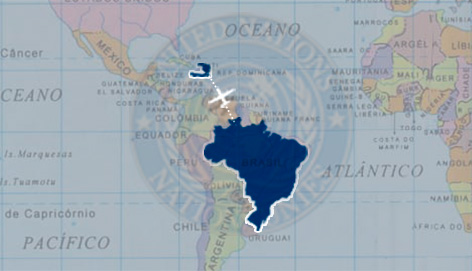HUMANITARIAN LOGISTICS AND THE PERFORMANCE OF BRAZILIAN ARMED FORCES IN UN PEACEKEEPING MISSIONS
DOI:
https://doi.org/10.22480/revunifa.2023.36.456Keywords:
Humanitarian Logistics, Peace mission, cohesion, Brazilian Air Force, PlanningAbstract
Humanitarian logistics presents itself as a factor that has the function of ensuring, with efficiency and effectiveness, the flow of people and resources. In addition, it ensures adequate planning for activities to support communities affected by emergency situations, whether caused by natural disasters or even by terrorist attacks, wars, among others, demonstrating that they need significant attention. In this sense, the performance of the Brazilian FFAA can be seen, which are responsible for the security of society. In this way, they can provide the humanitarian logistical support needed to carry out peacekeeping missions in these chaotic regions that lack support. Thus, the present work aims to analyze the importance of adequate humanitarian logistics and the role of the FAB in peace missions. In addition, the exposure of the necessary aspects is essential so that there is a good preparation on the part of the active military, aiming to gradually help society. From the case of the peace mission in Haiti, it was possible to perceive that cohesion is essential to ensure logistics in the peace mission process.
References
BALLOU, Ronald H. Logística empresarial: transportes, administração de materiais e distribuição física. Atlas, 1993.
BRASIL, Ministério da Defesa. Estado-Maior Conjunto das Forças Armadas. Portaria
Normativa n. 9/GAP/MD, de 13 de janeiro de 2016. Aprova o Glossário das Forças
Armadas – MD35-G-01 (5ª Edição/2015) na forma do Anexo a esta Portaria Normativa. Diário Oficial da União, nº 14, 21 de janeiro de 2016. Acesso em: 15 abr. 2021.
CARNEIRO, Lucas Gagno. A experiência das tropas brasileiras na missão de paz do Haiti. 2019. Disponível em: https://bdex.eb.mil.br/jspui/bitstream/123456789/6048/1/6397.pdf. Acesso em: 19 jun. 2021.
CORREA FILHO, Sérgio Leite Schmitt et al. Panorama sobre a indústria de defesa e segurança no Brasil. 2013. Disponível em: https://web.bndes.gov.br/bib/jspui/bitstream/1408/2684/1/BS%2038_panorama%20s obre%20a%20industria%20de%20defesa_P.pdf. Acesso em: 18 abr 2021.
COSTA, Sergio Ricardo Argollo da; BANDEIRA, Renata Albergaria de Mello; CAMPOS, Vania Barcellos Gouvea. Uma análise do processo de distribuição na cadeia de suprimentos em operações humanitárias. 2012.
FERES JUNIOR, Fuéde. Atributos afetivos e cognitivos, identificados nos militares da seção de assuntos civis da Minustha, capazes de favorecer as futuras operações de paz. 2018.
LONGARAY FILHO, André Andrade. A logística humanitária desenvolvida pela ONU no apoio à população em situações de calamidade pública. 2018.
MACEDO, Letícia. Missão de Paz no Haiti: 9 momentos para entender a história da operação liderada pelo Brasil. 2017. Disponível em:
https://g1.globo.com/mundo/noticia/missao-de-paz-no-haiti-9-momentos-paraentender-a-historia-da-operacao-liderada-pelo-brasil.ghtml. Acesso em: 25 abr. 2021.
MATHIAS, Suzeley Kalil; PEPE, Leandro Leone. Segurança e democracia: a atuação do Brasil no Haiti. 2006. Disponível em: https://www.resdal.org/producciones-miembros/art-mathias-lasamar06.pdf. Acesso em: 13 ago. 2021.
NISHIMORI, Flávio. Infantaria da Aeronáutica retorna à Missão de Paz da ONU. Este será o 9º pelotão enviado pela FAB ao país caribenho. Força Aérea Brasileira, 05 nov. 2016. Disponível em:
https://www.fab.mil.br/noticias/mostra/28197/AEROVIS%C3%83O%20%20De%20volta%20ao%20Haiti. Acesso em: 11 maio 2021.
SILVA, André Luiz da. Determinantes da prática de treinamento físico em militares em missão de paz no Haiti (MINUSTAH) nos períodos pré, durante e pós-missão: um estudo retrospectivo. 2018. Disponível em: https://revistadeeducacaofisica.emnuvens.com.br/revista/article/view/807/886. Acesso em: 21 jul. 2021.
SILVA, Guilherme Godoy Ribeiro da; ANDRADE, João Carlos Maia de. O apoio logístico de forma autônoma e eficaz como forma de evitar que as tropas fiquem desguarnecidas no terreno. 2018. Disponível em: https://bdex.eb.mil.br/jspui/bitstream/123456789/2761/1/MONO_GODOY_ESAO.pdf. Acesso em: 15 ago. 2021.
THOMAS, Anisya S.; KOPCZAK, Laura Rock. From logistics to supply chain management: The path forward in the humanitarian sector. Fritz Institute. 2005.
TUMELERO, Naína. Metodologia do TCC: como delimitar com lista de exemplos. [S. l.]: METTZER, 24 fev. 2018. Disponível em:< https://blog.mettzer.com/metodologia-tcc/>. Acesso em: 26 set. 2020.
VARELLA, Leonardo; MACIEL NETO, T.; BUSS, M. B. Logística militar x logística humanitária: conceitos, relações e operações das forças armadas brasileiras. In: Anais do XXVII Congresso de Pesquisa e Ensino de Transportes. 2013.
VIVEIROS FILHO, Marco Antônio Nobre de. Missão de paz brasileira no Haiti (2004-2017): Estratégias para o sucesso no enfoque psicossocial. 2019.
Disponível em: https://bdex.eb.mil.br/jspui/bitstream/123456789/5294/1/Artigo%20Cient%C3%ADfic

Downloads
Published
Issue
Section
License
Copyright (c) 2023 Ana Beatriz de Souza Pereira, Luiz Gustavo Antonio de Souza

This work is licensed under a Creative Commons Attribution-NonCommercial 4.0 International License.
Revista da UNIFA permite que o (s) autor (es) mantenha(m) seus direitos autorais sem restrições. Atribuição-NãoComercial 4.0 Internacional (CC BY-NC 4.0) - Revista da UNIFA é regida pela licença CC-BY-NC








